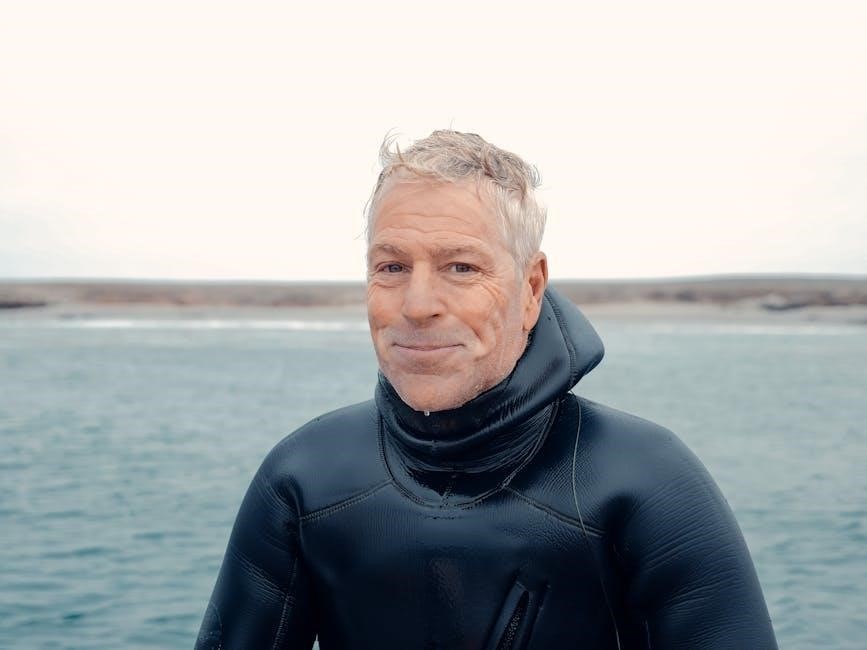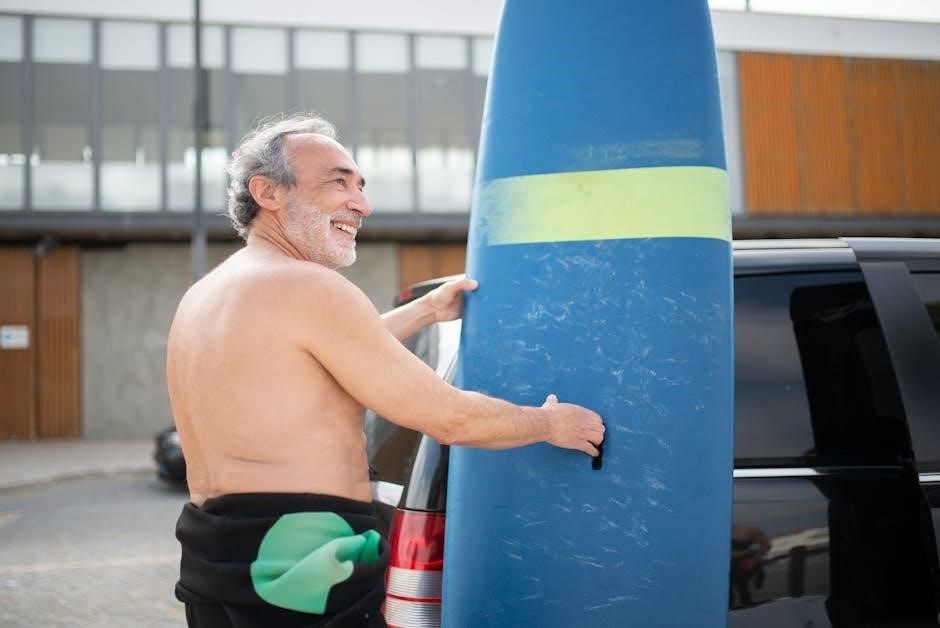
old man in the sea pdf
The Old Man and the Sea: An Overview
Ernest Hemingway’s “The Old Man and the Sea”, published in 1952, tells the story of Santiago, an aging Cuban fisherman. He battles a giant marlin in the Gulf Stream. This novella explores themes of struggle, defeat, triumph, and the relationship between man and nature.

Synopsis of The Old Man and the Sea
The story opens with Santiago, an old and experienced fisherman who has gone eighty-four days without catching a fish, a streak of bad luck that has made him the subject of pity in his village. He is so unlucky that Manolin, a young boy who used to fish with him, has been forced by his parents to work on a more successful boat. However, the boy still cares for the old man, helping him with his gear and providing him with food.
Determined to break his streak, Santiago rows far out into the Gulf Stream. He encounters a magnificent marlin, much larger than his skiff. The marlin takes the bait, and a long and arduous battle begins. For days, the old man is pulled by the great fish, enduring exhaustion and pain. He admires the marlin’s strength and nobility, even considering it an equal. Despite his suffering, Santiago refuses to give up, declaring that “man is not made for defeat.”
Finally, after days of struggle, Santiago manages to harpoon the marlin. He lashes it to the side of his boat and begins the long journey back to shore. However, the marlin’s blood attracts sharks. Santiago fights them off with his harpoon, knife, and even his bare hands, but they relentlessly attack the marlin. By the time he reaches land, the sharks have devoured the marlin, leaving only its skeleton.
Exhausted and defeated, Santiago returns to his shack and falls asleep. Manolin, worried about the old man, finds him and is relieved to see him alive. The boy promises to fish with Santiago again, believing in his skill and determination. The story ends with Santiago dreaming of lions on the beaches of Africa, a recurring image representing his youth and strength.

Santiago: The Old Man’s Character
Santiago, the protagonist of “The Old Man and the Sea”, is a complex and compelling character. He is an aging Cuban fisherman, weathered by years of hard work and hardship. Despite his age and recent run of bad luck, Santiago possesses unwavering determination and resilience. He is a man of immense pride, refusing to be defeated by the challenges he faces. His humility is evident in his respect for the sea and its creatures, particularly the marlin he battles.
Santiago embodies stoicism, enduring pain and suffering with quiet dignity. He doesn’t complain or give in to despair, even when faced with seemingly insurmountable odds. His inner strength is a defining characteristic. He engages in a mental dialogue with himself, bolstering his resolve and reminding himself of his capabilities. This self-reliance underscores his solitary existence and his deep connection to the natural world.
Despite his isolation, Santiago is not without human connection. His relationship with Manolin, the young boy who cares for him, reveals his capacity for affection and mentorship. He sees Manolin as his successor, someone to whom he can pass on his knowledge and skills. Santiago’s character is a testament to the enduring power of the human spirit, even in the face of adversity. He is a symbol of perseverance, courage, and the ability to find meaning in the struggle itself.

The Marlin: A Symbol of Struggle
The marlin in Ernest Hemingway’s “The Old Man and the Sea” transcends its literal existence, becoming a potent symbol of struggle, nobility, and the interconnectedness of life. The marlin is not merely a fish to be caught; it represents the ultimate challenge, a worthy adversary that tests Santiago’s strength, skill, and endurance. Its immense size and power symbolize the formidable forces of nature and the relentless nature of life’s battles.
The marlin’s unwavering determination mirrors Santiago’s own. Despite being hooked and enduring immense pain, the marlin refuses to yield. This shared tenacity creates a sense of mutual respect between the old man and the fish. Santiago admires the marlin’s nobility and considers it an equal. The struggle between them is not simply a contest of strength but a profound connection forged through shared hardship.
Ultimately, the marlin represents the unattainable ideal, the thing that drives us to push beyond our limits. Even though Santiago eventually loses the marlin to the sharks, the struggle itself is what defines him. The marlin’s sacrifice, and the respect Santiago holds for it, elevates the story beyond a simple fishing tale. It becomes a meditation on the human condition, the nature of ambition, and the dignity found in both victory and defeat. The marlin is a magnificent creature, embodying the beauty and brutality of the natural world.
Manolin: The Boy’s Significance
Manolin, the young boy in “The Old Man and the Sea”, is far more than just a side character; he is integral to understanding the novel’s themes of hope, loyalty, and the cyclical nature of life. He represents unwavering faith in Santiago, especially during the old man’s prolonged period of bad luck. While others lose confidence, Manolin continues to support and care for Santiago. His dedication highlights the importance of human connection and the power of belief.
Manolin’s role extends beyond mere companionship. He symbolizes the passing of knowledge and skills from one generation to the next. Santiago teaches Manolin about fishing, but also about life, resilience, and respect for the sea. Their relationship demonstrates the value of mentorship and the importance of preserving traditions. Manolin’s presence also provides Santiago with a sense of purpose and validation. The old man’s concern for the boy’s well-being motivates him during his arduous struggle with the marlin.
Furthermore, Manolin embodies the potential for renewal and the continuation of Santiago’s legacy. He represents a future where the old man’s values and wisdom will endure. At the end of the story, Manolin reaffirms his commitment to Santiago, ensuring that the old man’s spirit of perseverance will live on. He is the embodiment of hope, suggesting that even in the face of defeat, there is always the promise of a new beginning.
Themes in The Old Man and the Sea
“The Old Man and the Sea” explores universal themes. These include man versus nature, defeat and triumph, and pride and humility. The novel examines resilience, the dignity of struggle, and the cyclical nature of life and death in the vast ocean.
Man vs. Nature
“The Old Man and the Sea” profoundly explores the theme of man versus nature, portraying a complex relationship where respect and antagonism intertwine. Santiago’s epic battle with the marlin is not merely a contest of strength but a testament to human endurance in the face of nature’s immense power.
The sea, presented as both a provider and a relentless force, embodies nature’s duality. Santiago acknowledges the sea’s beauty and bounty while understanding its capacity for destruction. His struggle highlights humanity’s place within the natural world. He is not the master but a participant in its grand dance.
The marlin, a magnificent creature, symbolizes the untamed aspects of nature. Santiago admires the marlin’s strength and nobility, recognizing it as a worthy adversary. This admiration underscores the theme of respect for nature, even in the throes of conflict. Santiago’s respect sets him apart from those who seek only to dominate and exploit the natural world.
Ultimately, the story suggests that man and nature are inextricably linked. While humans strive to conquer and control their environment, they remain subject to its laws and forces. The novel suggests that harmony lies in understanding and respecting nature’s inherent power and beauty, not in seeking to subdue it.
Defeat and Triumph
“The Old Man and the Sea” presents a nuanced exploration of defeat and triumph, challenging conventional notions of success. While Santiago physically returns empty-handed, stripped of his prize by sharks, his spirit remains unbroken. This paradox forms the core of the novel’s message.
Santiago’s initial eighty-four days without a catch represent a period of apparent defeat, shaking his confidence and diminishing his reputation. However, his perseverance and unwavering determination demonstrate a refusal to succumb to despair. This resilience is a victory in itself, highlighting the strength of the human spirit.
The capture of the marlin symbolizes a moment of triumph, validating Santiago’s skill and experience. He proves his worth as a fisherman and reaffirms his connection to the sea. Yet, the subsequent loss of the marlin to sharks underscores the inevitability of loss and the transient nature of earthly achievements.
Ultimately, Santiago’s triumph lies not in material gain but in his unwavering spirit and his ability to face adversity with courage and dignity. Even in defeat, he retains his pride and self-respect, demonstrating that true victory lies in the struggle itself, not necessarily in the outcome. His experience teaches that it is possible to be defeated without being destroyed.
Pride and Humility
The interplay of pride and humility is a central theme in “The Old Man and the Sea.” Santiago possesses a deep sense of pride in his abilities as a fisherman. He sees himself as a worthy adversary to the marlin and is determined to prove his strength and skill. This pride fuels his relentless pursuit, pushing him beyond his physical limits.
However, Santiago’s pride is tempered by a profound humility. He respects the marlin, acknowledging its power and beauty. He never views the fish as a mere object to be conquered, but rather as a noble opponent deserving of respect. This humility allows him to appreciate the natural world and his place within it.
The old man recognizes his limitations, accepting the challenges posed by the sea and the sharks. He understands that he is not invincible and that defeat is a possibility. This awareness prevents his pride from becoming arrogance, allowing him to maintain a sense of perspective throughout his ordeal.
Santiago’s humility is further evident in his relationship with Manolin. He accepts the boy’s assistance and friendship, recognizing the value of human connection. Ultimately, Santiago embodies a balanced perspective, where pride in one’s abilities is tempered by respect for nature and humility in the face of adversity. This balance allows him to endure his struggles with grace and dignity.

The Struggle with Sharks
After Santiago successfully catches the marlin in “The Old Man and the Sea”, his arduous journey isn’t over; it intensifies with the arrival of sharks. These predators represent a new and formidable challenge, testing his endurance and resolve even further. The sharks are not noble opponents like the marlin; they are scavengers driven by instinct, stripping away Santiago’s hard-won prize.
The old man battles the sharks with all his might, using his harpoon, knife, and even the boat’s oar as weapons. Each shark represents a loss, diminishing his triumph and pushing him closer to defeat. Despite his efforts, the sharks relentlessly attack, tearing chunks of flesh from the marlin’s carcass.
Santiago’s struggle against the sharks can be interpreted as a metaphor for the inevitable forces of destruction that chip away at human achievement. It highlights the transient nature of success and the constant battle against forces beyond our control. His determination to fight, even when faced with overwhelming odds, showcases his unwavering spirit.
Though he ultimately fails to protect the entire marlin, Santiago’s resistance demonstrates his refusal to surrender. He embodies the idea that a man can be destroyed but not defeated. The sharks may take his prize, but they cannot take his courage, skill, or the memory of his epic battle.
Download Options: PDF and eBooks
For those eager to immerse themselves in Ernest Hemingway’s timeless classic, “The Old Man and the Sea”, numerous options exist to download the story in both PDF and eBook formats. These digital versions offer convenient access to the novella, allowing readers to enjoy it on a variety of devices, including computers, tablets, e-readers, and smartphones.
PDF versions are widely available across the internet, often from online libraries, educational websites, and literary archives. These files retain the original formatting of the printed text, making them ideal for those who prefer a traditional reading experience. Many PDF versions are also free to download, providing an accessible way to engage with Hemingway’s masterpiece.
eBook versions, such as EPUB and MOBI files, are specifically designed for e-readers and reading apps. These formats offer adjustable font sizes, customizable margins, and built-in dictionaries, enhancing the reading experience. eBook versions can be purchased from online retailers like Amazon Kindle Store, Google Play Books, and Apple Books. Many free eBook versions are also available from Project Gutenberg and other similar platforms.
Before downloading, be sure to verify the source to ensure the file is legitimate and free from malware. Whether you choose a PDF or an eBook, accessing “The Old Man and the Sea” digitally allows you to carry this powerful story with you wherever you go, ready to be revisited and pondered at your convenience.